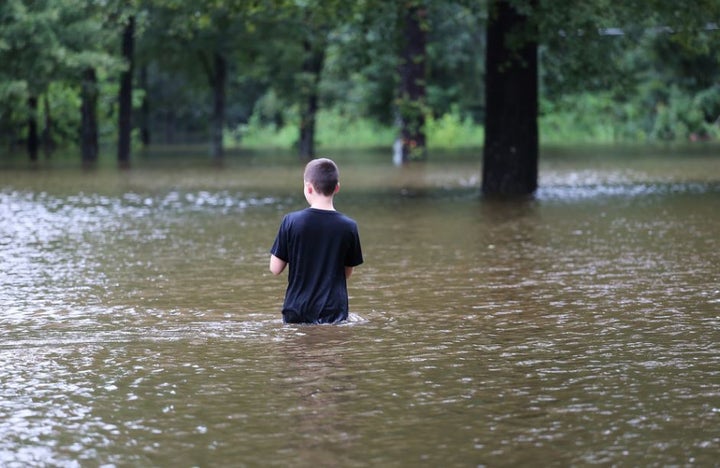
Watching the water level slowly rise outside her house, seven-year-old Molly wasn’t sure what she was supposed to do. Her Mom and Dad were monitoring the weather channel and checking their phones constantly trying to both assess the current situation and anticipate what might come next. They were playing it cool but they were clearly nervous; they had shared with Molly that if the water level from Hurricane Harvey got much higher, they would have to go upstairs to their neighbor’s apartment to stay safe. They had also said that at any minute the electricity could go out and not to be afraid. But while the lights were still on, the power had already been transferred and was now in Molly’s hand, in the form of a flashlight that she clung to for when it would go dark. Molly took her role seriously and kept going from window to window of their Houston apartment reporting on the water level and asking if it was time to go upstairs. Soon, the water was all around their building and brave Molly asked, “…what happens if we can never get out?”
What happens if we can never get out?
Many of the immediate effects of a major disaster are visible to the public eye – like the water that was rising outside Molly’s home – but the long-term psychological impacts of a major emergency are harder to see. In Molly’s case, things didn’t get a lot worse; the power did go out but the family did not have to relocate upstairs. That said, Molly still cries every time it rains and she insists on sleeping in her parent’s room. The flooding may have gone away, but the impact of the experience for Molly is still there.
Data tells us that children, even more so than adults, can face significant mental, emotional and physical consequences after a major disaster. Additionally, those most vulnerable after an emergency were most likely the most vulnerable before the crisis onset. Children who live in poverty are often more affected by crises such as hurricanes, as trauma experienced as a result of the storm can exacerbate existing stress and the cumulative effects of challenges, which are already dis-proportionally prevalent. Houston is a prime example.
According to a 2016 Dallas News analysis, of the more than 1 million children who live in Harris County – where Houston sits – about 26% live below the poverty line. The Houston Independent School District (HISD) that serves Harris County is the largest school district in Texas hosting some 250,000 students – 80% of whom are economically disadvantaged. And according to Texas Children’s Hospital experts, even before Hurricane Harvey there were service and service capacity gaps. While HISD clinicians provide mental health support to more than 2000 traumatized youth annually, an estimated 14,000 additional children and young people have unmet needs due to lack of providers, lack of knowledge about available programs, lack of financial resources and fear of deportation. And this was before Harvey.
But all is not lost; on a recent visit to Houston we found numerous examples of inspirational vision and commitment from Houston’s leaders. For example, HISD leadership, aware that following such a traumatic event that a higher level of mental, emotional and behavioral issues among children and teens is predictable, are already taking steps. Last year, in a move that seems even more visionary in hindsight, HISD staff took part in professional development on the basics of trauma-informed education. Teachers are the front lines in recognizing trauma in children and these new tools will assist teachers in spotting the different ways children's stresses may show up in the classroom.
Recognizing reactions to trauma, like Molly’s behavior noted earlier, is really step one of a more formal process of assessing a child’s mental health status. In the first few weeks after the event, many of these behaviors are very normal, and can be expected for children. Part of what will be important training for parents and others who care for children is knowing when behavior after events like evacuation or flooding go beyond the usual, age-appropriate response, and what kinds of support can help children cope. Not every child will require individual treatment, but the pathway and process must be in place to assure that children who manifest more severe symptoms, and who need formal support, are identified and have somewhere to go.
This is where experts in trauma and grief programming at Texas Children’s Hospital and experts in programs for children in poverty affected by public health crises at our organization, Children’s Health Fund, are partnering and stepping in. Using evidence-based approaches of intervention, we are together launching the Harvey Resilience & Recovery Program - a comprehensive initiative that will: a) train educators and community leaders on what to expect from children in the aftermath of Hurricane Harvey; b) train those same leaders on how to identify and spot risk markers among Hurricane Harvey exposed youth; c) empower those leaders with tools to know when kids may need more help; and finally, d) establish best-practice service models for ensuring effective treatment. It is a resilience and recovery model that can change the way we look at trauma informed for care for children post-disaster for years to come.
Resilience is defined by the American Psychological Association as the process of adapting well in the face of adversity, trauma, tragedy, threats or significant sources of stress. Hurricane Harvey seemed to represent all of those stress challenges – but leaders in Houston are using this crisis as an opportunity to not just build-back-better, but build back stronger – Houston Stronger. Leaders like Dr. Mark Kline and Dr. Julie Kaplow at Texas Children’s Hospital are making sure that the resources and tools are in place to not just identify, but provide a pathway to healing for trauma impacted children. Many children, just like Molly, want to be brave and want to get back to their own room. The work of Texas Children’s Hospital, Children’s Health Fund, and partners, will make this journey possible.
Dennis Walto, MA & Delaney Gracy, MD
www.childrenshealthfund.org
